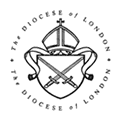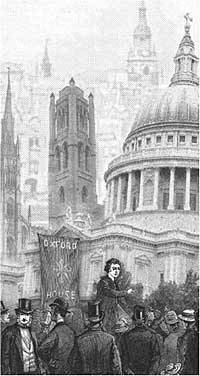Historical themes in the Diocese of London: Reading about faith and worship
- What can I read on the relationship of church architecture and fittings, faith and worship in Britain ?
- What can I read on Anglican beliefs, theology and worship?
- What can I read on other religious traditions and unbelief in the nineteenth century?
What can I read on the relationship of church architecture and fittings, faith and worship in Britain ?
Perhaps the best place to start for anyone interested in nineteenth or eighteenth century church-buildings is a classic study by Nigel Yates:
Nigel Yates, Buildings, Faith and Worship: The Liturgical Arrangement of Anglican Churches 1600-1900 (Oxford University Press, revised edition 2001).
Also very helpful, not least on the effect of non-religious factors on things that may seem related to faith, are several essays in:
Chris Brooks & Andrew Saint (eds.), The Victorian Church: Architecture and Society (Manchester University Press, 1995).
Of particular importance for the late nineteenth century was the impact of the Ecclesiological or ‘Cambridge' Movement and then Anglo-Catholic ritualism, which placed great stress on the physical environment of worship (it preferred medieval models), forming a key dimension of a wider ‘gothic revival' A good introduction to this theme is:
J. F. White, The Cambridge Movement : The Ecclesiologists and the Gothic Revival (Cambridge University Press, 1962).
See also the website of the Ecclesiological Society, a good hub for all those interested in church architecture: www.ecclsoc.org.
See also the books recommended on the architecture research page.
What can I read on Anglican beliefs, theology and worship?
Victorian religion is well served by accessible and insightful studies which often include much on this theme in the course of more general accounts. For sheer pleasure in the reading, nothing can beat Owen Chadwick's two-volume magnum opus: a large book that is nonetheless compulsively readable:
Owen Chadwick, The Victorian Church, 2 vols. (A & C Black, London, 1971-2)
In certain respects, however, this book now shows its age. There are several useful more recent studies (though in some cases they concentrate more on the rural environment than the urban). Two excellent places to start are
Frances Knight, The Nineteenth-Century Church and English Society (Cambridge University Press, 1995)
Gerald Parsons (ed.), Religion in Victorian Britain, 4 vols. (Manchester University Press, 1988), esp. vols. 1, 2, 4.
Those interested in an earlier period might also find useful
William Jacob, Lay People and Religion in the early eighteenth century (Cambridge University Press, 1996)
For the early twentieth century, a controversial but impressive account of London believers paying a lot of attention to what might be regarded as ‘superstition' as well as more orthodox belief is to be found in
arah Williams, Religious Belief and Popular Culture in Southwark, c. 1880-1939 (Oxford University Press, 1999)
See also
Adrian Hastings, A History of English Christianity 1920-2000 (SCM, 2001)
The nineteenth century is often seen as one of the great ages of ‘church parties', self-conscious groupings who competed for the allegiance of clergy and churchgoers alike, and which found expression in competing societies and codes of worship and dress. For a lively and readable contemporary account, nothing beats William Conybeare's essay, ‘Church Parties' published in the Edinburgh Review in 1853, which can be accessed in a good modern edition in:
Stephen Taylor (ed.), From Cranmer to Davidson (Church of England Record Society publications, vol 7, 1999)
Those interested in particular traditions (for much of the nineteenth century it makes at least some sense to speak of ‘high'/tractarian/anglo-catholic; low/protestant/evangelical; broad/liberal) are directed in the first instance to the specific studies listed below.
For the ‘high tradition' (particularly well served!):
John Shelton Reed, Glorious Battle: The Cultural Politics of Victorian Anglo-Catholicism (Vanderbilt University Press, 2000)
Brad Faught, The Oxford movement: A thematic history of the Tractarians and their Times (Pennsylvania State University Press, 2004).
K. Hylson-Smith, High Churchmanship in the Church of England from the sixteenth century to the late twentieth century ( Edinburgh, 1993)
For evangelicalism:
David Bebbington, Evangelicalism in modern Britain: A History from the 1730s to the 1980s (Routledge, 1988)
Kenneth Hylson-Smith, Evangelicals in the Church of England 1734 to 1984 (Continuum, 1992)
For broad/liberal churchmanship (comparatively poorly served):
Tod E. Jones, The Broad Church: A Biography of a Movement (Lexington Books, 2003)
A good place to look for further reading is on the website of The Victorian Web, with its extensive resources and bibliography: www.victorianweb.org/religion/
What can I read on other religious traditions and unbelief?
There are some useful essays on all the themes that follow in
Gerald Parsons (ed.), Religion in Victorian Britain, 4 vols. (Manchester University Press, 1988), esp. vols. 1, 2, 4.
For other Christian denominations, see for Protestant Dissent:
Michael Watts, The Dissenters vol. 2: The Expansion of Evangelical Nonconformity (Oxford University Press, 1995)
For Roman Catholicism:
E. R. Norman, The English Catholic Church in the Nineteenth Century (Oxford University Press, 1985)
Mary Heimann, Catholic Devotion in Victorian England (Oxford University Press, 1995)
For irreligion:
Susan Budd, Varieties of Unbelief: Atheists and Agnostics in English Society 1850-1960 (Heinemann, 1977)
Timothy Larsen, Crisis of Doubt: Honest Faith in nineteenth-century England (Oxford University Press, 2006)
David Nash, Blasphemy in Modern Britain: A History 1789 to the Present (Ashgate, 1999)
A good place to look for further reading is on the website of The Victorian Web, with its extensive resources and bibliography: www.victorianweb.org/religion/






